1 The Technological Future – Merging with Machines [Toebes]
OBJECTIVES
- Students shall comprehend the different forms of integration of the human body with machines.
- Students shall understand the differences between Replacement of body parts, Augmentation to go beyond human limits and Simulation to fool our senses as well as our Connection to the machines of the world.
INTRODUCTION
The world continues to evolve, and people have always sought to improve how to live and control their interactions with that changing world. With integration between the human body and the many machines that we create, we seek to improve both our longevity and how we experience and perceive everything around us.
This level of integration can be broken into three approaches: Replacement, Augmentation and Simulation. Each of these strategies affect our connection to the world.
In the simplest form, Replacement is about substitution of an external creation for a failing or missing part. From life sustaining parts such as artificial hearts to functional prosthetic limbs, the goal is to bring a body up to an expected level of performance.
Taking the next step with Augmentation is to make the replacement part perform a function better than what was originally done such as a bionic eye or to add a new function to the body such as infrared vision or magnetic sensing. It is worth noting that there is a fine line between Replacement and Augmentation based on the intention.
At the extreme, Simulation allows feeding external stimuli directly into the body fooling it into believing that something artificial is actually happening. While images of movies like The Matrix may come to mind, this last category is well entrenched in today’s youth through online gaming which strives to provide a more realistic and encompassing experience.
All of these strategies for integrating with the machines of the world are predicated on the human mind still being in control. Note that strategies with an Artificially Intelligent entity are addressed in the next chapter.
REPLACEMENT – MECHATRONICS
We have always had a need to replace the functionality of a lost body part to varying degrees. The most obvious being the loss of a limb being replaced by a prosthetic equivalent. It should be no surprise that the oldest known prosthetic is over 3,000 years old: the Greville Chester Great Toe [Figure 1‑1] (Daley, 2017) (Choi, 2007) (Dvorsky, 2017) which was made from wood and leather that was made for a 50-60 year old woman. What is significant about this early prosthetic is that it was designed to operate like the body part it replaced unlike earlier ones which were just an imitation of the part but not functional and hence difficult to wear over an extended period.
Figure 1‑1: Ancient Egyptian Prosthetic Toe
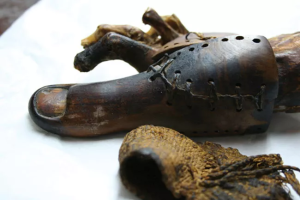
Image: Dr Jacky Finch, courtesy of the Egyptian Museum, Cairo
Source: https://cdn.mos.cms.futurecdn.net/3g5JAizfnWiPduq9LSJxW8-1200-80.jpg.webp
Another early attempt at replacing a missing limb is the Capua Leg from 300 BC (Copy of Roman artificial leg, London, England, 1905-1915) which was created in bronze. While this was one of the earliest known leg prosthetics, the construction of it from bronze would have made it uncomfortable to wear. Although the original was destroyed during an Air Raid in World War II, modern 3D printing techniques have allowed researchers at the Peter Osypka Institute of Medical Engineering (Otte & Hazubski, 2019) to create a replica to understand how it originally operated.
Figure 1‑2: Capua Leg – 300BC
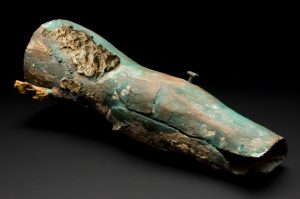
Credit: Copy of Roman artificial leg, London, England, 1905-1915. Science Museum, London.
Source: https://wellcomecollection.org/works/kyjgqfuh/images?id=ja6vhwvc
3D PRINTING REPLACEMENT PARTS
It is only in the past couple of decades that 3D printing has progressed to the level that it can be used to create replacement prosthetics. In fact, 3D printing has made it possible for the average person to create a viable substitute limb and digits. We have seen simple designs from six girls on a Girl Scouts based FIRST Lego League team (Iowa Girl Scouts, 2011) who created a prosthetic hand device to enable a 3-year old girl (Figure 1‑3) to write (Boyle, 2011). (United States of America Patent No. 8,840,157, 2014)
Figure 1‑3: Prosthetic Hand device to enable writing

Source: (United States of America Patent No. 8,840,157, 2014)
Other robotics teams have created more complex designs working with the e-nable organization (Enabling The Future). Based on the e-nablev designs, a FIRST Robotics team of 25 high school students 3D printed a functioning prosthetic hand (Figure 1‑4). (FIRST Robotics, 2021)
Figure 1‑4: 3D Printed Prosthetic Hand
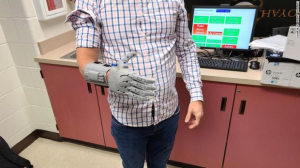
Source: https://community.firstinspires.org/hubfs/201224202633-01-high-school-robotics-custom-prosthesis-trnd-exlarge-169-1.jpg
From https://community.firstinspires.org/first-robotics-competition-team-creates-prosthetic-hand
Another group has taken the e-nable design to the next level creating an Iron Man themed functioning prosthetic arm (Figure 1‑5) (Grunewald, 2016). By creating a series of superhero themed prosthetic limbs, not only have the recipient gained use of a missing limb, the themed prosthetics often cause them to become the envy of their classmates.
Figure 1‑5: 3D Printed parts for Iron Man Prosthetic Arm
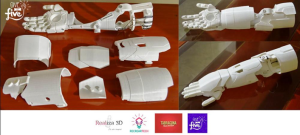
Source: https://3dprint.com/wp-content/uploads/2016/02/3dp_ironman_enable_parts-e1455887598231.jpg
An advantage of many of these 3D printed prosthetics is that they are inexpensive to manufacture and replace as well as simple to maintain because they rely on existing muscles to control them. However, other advancements in technology have allowed for much more complex control of the replacement parts. It is important to note that for much of the population, a high-quality prosthetic can be out of reach from a cost perspective. It is for this reason that there continues to be innovation in low-end and open-source technologies. Often work goes in both directions to produce high end prosthetics while at the same time using those learnings in order to produce a more cost-effective version.
It is also worth noting that people with replacement parts can perform at some of the highest levels of athletics. Already in the Paralympics we have competitors with prosthetic limbs or wheelchair bound coming close to or even beating Olympic times (Buchholz, 2021). In fact, the performance and perceived advantage of blade running athletes has led to the Olympics committee banning such athletes from competing against athletes without prosthetics, but a study published in the Royal Society Open Science shows that no such advantage exists. (Beck, Taboga, & Grabowski, 2022) The fact that we are having to have this level of discussion attests to the advancement of Replacement and shows how we are very quickly moving into the realm of Augmentation.
BIOMECHATRONICS
As the technology for replacement of body parts goes beyond the simple mechanical replacement of a body part with another physical replica, the integration of the replacement into the body requires additional technologies applied. This is the realm of biomechatronics in which the biological and mechanical disciplines are combined. Sometimes the learnings from a full biomechatronic implementation can be used to benefit a fully mechanical implementation.
One such example is at MIT where work has been done at both ends of the spectrum. At one end we have the MIT Media Lab biomechatronics group (MIT Media Lab) which has done extensive research on the augmentation front in ways to power a prosthetic knee (MIT Media Lab) and even have engineers who have built their own bionic leg (MIT Media Lab, 2019). At the other end of replacement, they also have teams creating a more cost-effective prosthetic knee which is powered only by springs and gears. (MIT News, 2015) (MIT GEAR Lab) (Chu, 2015)
In addition to MIT, some of the top biomechatronics researchers include the Shirley Ryan AbilityLab (Shirley Ryan AbilityLab) the University of California at Berkeley (University of California at Berkeley), Stanford University (Stanford University), and University of Twente in the Netherlands (University of Twente, 2020). These researchers have been focusing on the critical data gathering necessary to make functioning replacements. This data gathering includes analyzing the complex human motions, determining how to interface electronic components to the human nervous system and experimenting with living muscle tissues as potential actuators for electronic devices.
EXOSKELETONS
While replacement of missing limbs is one approach for allowing people to use them again, when a limb or part of the body becomes paralyzed, another approach to regain use is through an exoskeleton. While this seems like it may be a new technology, in fact the concept of an exoskeleton was first patented in 1890 by Russian inventor Nicholas Yagn (YAGN, 1890). This early exoskeleton was designed as an Augmentation to walking, running, and jumping powered by a combination of springs and compressed fluid. Almost 20 years later, Leslie Kelley patented the Pedomotor (Kelley, 1919) which used steam power to augment human motion with artificial ligaments. Since then, there have been many attempts at exoskeletons as can be seen in Figure 1‑6. (Qui, Pei, & Wang, 2022)
Figure 1‑6: Historical Exoskeletons
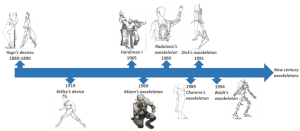
Source: https://www.mdpi.com/applsci/applsci-11-00076/article_deploy/html/images/applsci-11-00076-g001.png
From: (de la Tejera, Bustamante-Bello, Ramirez-Mendoza, & Izquierdo-Reyes, 2020)
https://www.mdpi.com/2076-3417/11/1/76
More modern research and development of exoskeletons can be split into either rehabilitation (e.g., Replacement) or assistance (Augmentation) (de la Tejera, Bustamante-Bello, Ramirez-Mendoza, & Izquierdo-Reyes, 2020). The Military is a major source of research into this technology both to provide recovery to veterans wounded on the battlefield and to augment the abilities of soldiers enabling them to carry more, move faster and avoid fatigue. Some of the recent efforts can be seen in Figure 1-7. (Qui, Pei, & Wang, 2022)
Figure 1‑7: Timeline of Exoskeletons 2014-2020
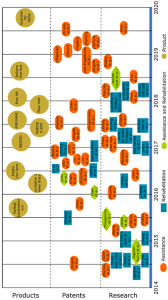
Source: https://www.mdpi.com/applsci/applsci-11-00076/article_deploy/html/images/applsci-11-00076-g004.png
From (de la Tejera, Bustamante-Bello, Ramirez-Mendoza, & Izquierdo-Reyes, 2020) https://www.mdpi.com/2076-3417/11/1/76
While many of these exoskeletons are far beyond the reach of the average consumer, some of the research has resulted in products that are being targeted at people who wish to extend their travel and adventuring range. One such product is the Shift Robotics AI powered Moonwalker shoes which are designed to allow a person to walk 250% faster (Figure 1‑8). (Shift Robotics, 2023). Another crowdfunded product is also an AI powered device – the Hypershell Exoskeleton which is designed to give a person 25KM or range offsetting 30KG of weight. (Figure 1‑9) (Hypershell, 2023). In the mid-range offering is the suitX exoskeleton which both enables a paraplegic individual to walk (Ashley, 2017) and is targeted to industry to augment a person doing their daily tasks by reducing the muscle strain of heavy lifting and increasing the endurance of the individual using the suit. (Ottobock, 2021)
Figure 1‑8: SHIFT MoonWalkers
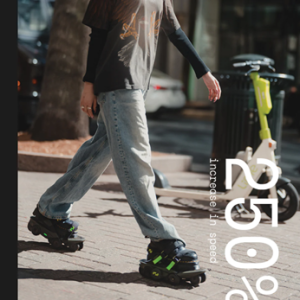
Source: https://cdn.shopify.com/s/files/1/0652/6238/7422/products/1.jpg
From: https://shiftrobotics.io/products/moonwalkers
Figure 1‑9: Hypershell
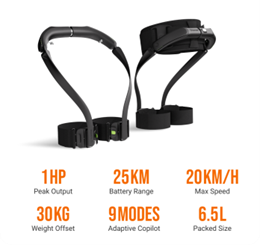
Source: https://c1.iggcdn.com/indiegogo-media-prod-cld/image/upload/c_limit,w_695/v1679988592/srxnwvrvzcj3bbhn03tv.png
From: https://www.indiegogo.com/projects/hypershell-exoskeleton-for-everyday-adventure–2
GIANT EXOSKELETONS
No discussion of exoskeletons can be had without looking at the giant robots that are created for recreational purposes. Although not technically an exoskeleton, the largest moving robot mech in the world is the 18 meter (59ft) tall “life-size” Gundam RX-78 (Figure 1‑10) in Yokohama, Japan (Japan, 2020). For Transformers fans, The J-deite RIDE is a 4 meter (13 foot) tall transforming robot that converts from a drivable car to a walking robot (Figure 1‑11). (BRAVE ROBOTICS Inc., 2018)
Figure 1‑10: Gundam Factory Moving RX-78 Gundam

Source: https://gundam-factory.net/images/gallery/second/second_006.jpg
From: https://gundam-factory.net/gallery/2nd_anniv/
Figure 1‑11: J-diete Ride Transforming Robot
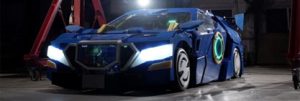
Source: https://j-deite.jp/wp-content/uploads/2018/04/P1190431-2.jpg
https://j-deite.jp/wp-content/uploads/2018/04/j-deite-ride-5.jpg
From: https://j-deite.jp/en/portfolio_page/j-deite-ride/
When someone wants to push the limits of an exoskeleton, think no further than what was built to compete in a robot duel. At 13 feet tall, weighing in at 4 metric tons (12,000 pounds) Kuratas (Kuritas, 2023) (HT Tech, 2021) was built by the Japanese company Suidobashi Heavy Industry (Figure 1‑12) . Kuritas participated in a match defeating Megabots Mark II and then tap out when Megabots Eagle One’s chainsaw ripped into Kuritas’s arm on October 17, 2017 (Carter, 2017). For a while they even offered the robot for sale on Amazon in Japan for the tidy sum of 120 million yen (US$1,008,000). (Baseel, 2015)
Figure 1‑12: Kuratas
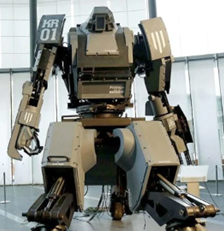
Source: https://images.hindustantimes.com/tech/img/2021/05/14/960×540/965492_Wallpaper2_1621008380272.jpg
From: https://tech.hindustantimes.com/photos/kuratas-japan-s-futuristic-robot-photo-62Ez674kIU0EyCkfrFGTUK.html
Another exoskeleton robot was built by Taguchi Industrial Co., Ltd – the Super Guzzilla (Figure 1‑13) which features their Guzzilla series concrete crusher claws. (Taguchi Industrial, 2023). This robot stands four meters (13.1 feet) tall and weighs 15 metric tons (33,000 pounds). When members of the public were given an opportunity to sit inside Super Guzzilla, they were given a virtual experience through an Oculus Rift VR headset with the actual robot controls driving the virtual robot. (Baseel, 2015)
Figure 1‑13: Super Guzzilla
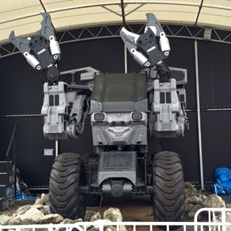
Source: https://soranews24.com/wp-content/uploads/sites/3/2015/07/gr-3.jpg
From: https://soranews24.com/2015/07/19/you-can-take-this-33000-pound-robot-for-a-virtual-test-drive-watch-it-dance-to-j-pop-%E3%80%90video%E3%80%91/
EXTRA BODY PARTS
Where prosthetics get to be more interesting is when they are used to add an additional body part to assist in a function. Anyone who has soldered an electronic circuit has always wished for a third hand. For those wanting an extra thumb, Dani Clode at Cambridge University created a 3D-printed thumb that can be added to any hand. (Amoruso, et al., 2022) (Figure 1‑14). Other uses envisioned are a surgeon who wants to hold a camera while doing shoulder surgery so that they can control where it points instead of having to rely on an assistant. (Davis, 2023)
Figure 1‑14: Extra thumb – Photograph: Tom Stewart
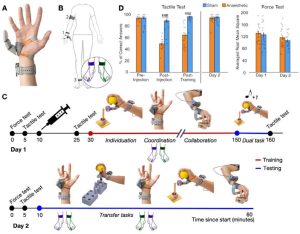
Source: (Amoruso, et al., 2022)
via Creative Commons Attribution 4.0 International License
3D PRINTING BIO PARTS
While prosthetics and exoskeletons can help with a missing or non-functioning limb, internal organs require a completely different approach for replacement. Transplanting an organ from another human requires careful type matching and immunosuppression treatment in order to prevent rejection of that organ. Some inroads in a machine to replace an organ have been made for the heart as well as external organs such as the kidney with a dialysis machine. However, the advent of rapid prototyping and bio materials offers an opportunity to create replacement organs which can be created from the recipient’s own cells. (Wang, 2019) (Wikipedia, 2023)
The bioengineers at Stanford University have been looking at how to approach building a human heart. (Levin, 2022) They start with modified stem cells processed through a centrifuge into a paste-like substance that is then printed into a gelatinous 3D structure (Figure 1‑15). While the bio printers being used at the research level can be quite costly, a team of students from Ludwigs-Maximillians-Universität and the Technische Universität München won the 2016 Hackaday Prize when they repurposed a low-end Ultimaker 2+ 3D printer with a syringe to show how it can be used for 3D Bioprinting. (Hofmann, 2016). In 2012, students in the University of Patras, Greece collaborated in modifying an Anet A8 3D printer (Figure 1‑16) to 3D print stem cells cultivated from wild mice. (Melanie, Markus, Phillipp, & Oliver, 2019)
Figure 1‑15: 3D bioprinter printing a sample. (Image credit: Andrew Brodhead)
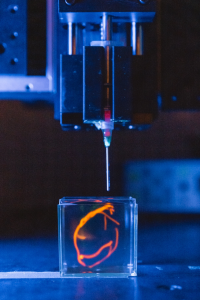
Source: https://news.stanford.edu/wp-content/uploads/2022/03/20220204_3D_Bioprinting_N6A8376.jpg
From: https://news.stanford.edu/2022/03/14/building-heart-one-layer-time/
Figure 1‑16: 3D Printing mice stem cells on an Anet A8 printer
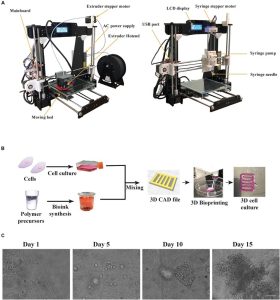
Source: https://www.frontiersin.org/files/Articles/580889/fbioe-08-580889-HTML-r2/image_m/fbioe-08-580889-g001.jpg
From: (Melanie, Markus, Phillipp, & Oliver, 2019)
MODIFYING THE BODY FROM THE INSIDE
It is one thing to manufacture a part outside the body and insert it, but we want to think about how machines could inhabit our body and automatically repair it. One approach to repairing the body is the use of hydrogels that are injected into targeted areas to assist the natural body repair mechanisms or even replace diseased tissues. Researchers at MIT and Harvard university have been working on models for how these granular hydrogels can be used both in 3D Bioprinting and injected into tissue. (Trafton, 2023) (Verheyen, Uzel, Kurum, Roche, & Lewis, 20223)
The next step is to have the 3D printer work inside the body to 3D print living cells directly on top of an organ. Researchers as UNSW Sydney Australia have developed 3D printer with a soft printer head (Figure 1‑17) that can be inserted endoscopically and print directly inside the body. (Firtina, 2023)(Thai, et al., 2023)
Figure 1‑17: 3D Printing inside the body
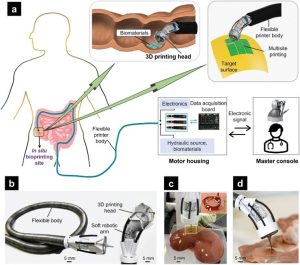
Source: https://onlinelibrary.wiley.com/cms/asset/9c5f5c50-5e03-4ef7-8ef6-d0f029f16ab4/advs5284-fig-0001-m.jpg
From: (Thai, et al., 2023)
The extreme version of this is a series of tiny machines that live in our body fixing whatever they find is wrong. This is the realm of Nanorobotics (Nanorobotics, 2023) and Nanomedicine (Nanomedicine, 2023) with active research driven by the National Nanotechnology Initiative (National Nanotechnology Coordination Office, 2023). While a general purpose nanobot for the human body is not currently available, this targeted research includes using nanoparticles to deliver medication directly to cancer cells (Aggarwal & Kumar, 2022) and regeneration of bone and tissue. (National Nanotechnology Coordination Office, 2023)
In order to perform their functions, these nanoscale robotic devices need to be able to move effectively through the body. There are multiple strategies for creating these nanomotors including 3D Printing, microfluid spinning, integration of biological and synthetic materials and using a porous polymer template as a scaffold (Figure 1‑18) (Liu, Gao, & Peng, 2022). In addition to being able to move through the body to target a particular cell or set of cells, nanoscale robots can also be used to help regulate the growth and differentiation of cells.
Figure 1‑18: Micro/nanomotors in Regenerative Medicine
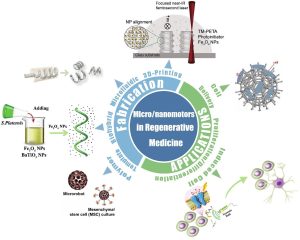
Source: https://ars.els-cdn.com/content/image/1-s2.0-S2590049822000777-gr1_lrg.jpg
From: https://www.sciencedirect.com/science/article/pii/S2590049822000777
Another approach for nanorobots in the body is to provide the power from outside the body in order to control where the treatment is to be applied. (Soon, et al., 2023). These untethered robots can be directed to a specific location with one frequency of a magnetic field and then switch into a heating mode when a higher frequency is applied. (Figure 1‑19)
Figure 1‑19: Pangolin-inspired RF heating mechanism for untethered magnetic robots
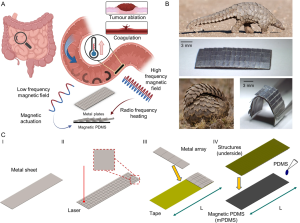
Source: https://media.springernature.com/full/springer-static/image/art%3A10.1038%2Fs41467-023-38689-x/MediaObjects/41467_2023_38689_Fig1_HTML.png
From: https://www.nature.com/articles/s41467-023-38689-x
BIOHACKING
Instead of waiting for the mainstream to catch up, some individuals have chosen to modify their own body in a process known as biohacking which involves the process of infusing technological components into the body or by introducing chemical components in order to modify DNA. What is key here is that these modifications are done using therapies and technology which has not gone through any governmental certification.
BIOHACKING – IMPLANTS
Implanting a device or magnet into an arm or hand is one of the simplest forms of biohacking. Steve Haworth is considered a pioneer in the field, implanting magnets into his body over 30 years ago and creating instruments for others to follow in his path. (Haworth, 2023) With a magnet, the individual can sense other magnetic objects and fields (including microwaves) and pick up small pieces of metal (Figure 1‑20). A challenge with implanting magnets is that they can degrade over time reducing the function of the magnet and the sense that it brings. (Robertson, 2017).
Figure 1‑20: Picking up a paper clip with an implanted magnet
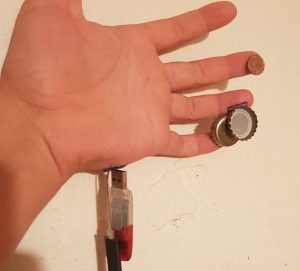
By 1mrln – Own work, CC BY-SA 4.0, https://commons.wikimedia.org/w/index.php?curid=115315463
A similar problem comes when embedding an RFID tag or other Near Field technology. A Hackaday.io project from 2014 promises to turn you into a “bionic superhero” by implanting a small device into the arm to provide communication with the outside world. (txyz.info, 2014). It is also possible to purchase an NFC Implant for under the skin – a crowdfunded Indegogo campaign in 2013 resulted in the production of the Dangerous Things xNT NFC chip implant that allows sharing data with NFC enabled smart phones (Dangerous Things, 2019). However, as the technology of the world continues to evolve, the implanted device is limited to accessing devices of the era when it was first implanted. For a person to be able to use their hand to pay for something in a contactless manner requires both a change in technology and agreements with the EMV contactless payment companies. (Graafstra, 2017)
Another problem to be aware of with any device under the skin is the potential for damage to the device or the body around it. After biohacker Lepht Anonym had a file sharing device with a WiFi antenna implanted in her arm, she accidentally damaged it when she hit her arm on the door of a taxi and had to have it removed because of the irritation to her skin. (Teresa, 2022).
Figure 1‑21: Project Bionic Yourself (B10N1C) implant in arm
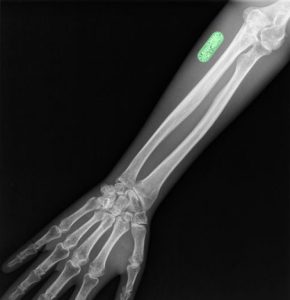
Source: https://cdn.hackaday.io/images/7176431409665975009.jpg
From: https://hackaday.io/project/2736-bionic-yourself-v20
When thinking about device obsolescence, in 2015 the World Economic Forum published a report expecting that implantable cell phones will be commercially available by 2023. (Global Agenda Councel on the Future of Software & Society, 2015). While that hasn’t happened, Marty Cooper, who is credited with inventing the first phone in 1973, recently stated that one day we will have phone devices embedded under our skin. (Browne, 2023). We shall leave what happens when it is time to upgrade the device as an exercise for the reader.
BIOHACKING – DNA
With implanted devices, there is always the option to remove the device. Another approach to biohacking is to target changing the body DNA. Despite all the peril of this form of DIY Gene Therapy, people continue to experiment with it, but often with disastrous results. (Schroeder, 2022) (Zhang, 2018). The use of CRISPR has made it easier for individuals to experiment with genetic engineering to the point that California has clamped down on the sale of kits for injection into individuals. To avoid such government oversight, a biotech startup called Minicircle that wants do to a clinical trial of gene therapy aimed at increasing longevity turned to using NFTs for access to trials in an experimental crypto city in Próspera, Honduras. (Clarke, 2023)
CONNECTING THE BODY
Not every connection to the machines around us requires implanting or modifying the body. Some technology can be done directly through the skin. Users of smart watches are already familiar with the ability to monitor body functions (heart rate, sleep tracking, blood oxygen and temperature). Another way to connect to the outside world is through a tattoo constructed of nanowires on top of a graphene aerogel conductive ink to allow for passive wireless communication to nearby devices without the need for an external power source similar to an RFID tag (Goth, 2023).
For detailed monitoring of muscle activity such as tracking a sports injury or the progress of a disease, researchers from six universities collaborated to create a soft wearable ultrasound sensor (Figure 1‑22) that can monitor over an inch and a half deep into the skin. (Halfacree, 2023)
Figure 1‑22: Wearable Ultrasonic Sensor
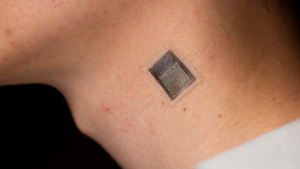
Source: https://hackster.imgix.net/uploads/attachments/1586951/image_WeqaxmgaNW.png
From: https://www.hackster.io/news/a-soft-wearable-ultrasound-sensor-peers-deep-under-your-skin-to-monitor-muscles-and-more-4e349a63eb16
READING THE BRAIN
The ultimate interface to the machines of the world is being able to control it with our thoughts. One of the most promising: Mary Lou Jepsen’s OpenWater mind reader is a non-invasive technology that uses light to reconstruct the activity in the brain. (Fazekas, How does OpenWater’s mind reader work?!, 2019). This allows for a form of telepathy such that thoughts of one individual can be transmitted to another. (Sánchez, 2023). An early experiment showing that this is possible was done in Barcelona in 2014 in which information read from one subject’s brain was encoded as a Baconian cipher encoded information and transmitted to another subject over 7,000 kilometers away to be successfully received. (Figure 1‑23) (Grau, et al., 2014)
Figure 1‑23: 2014 Telepathy Experiment
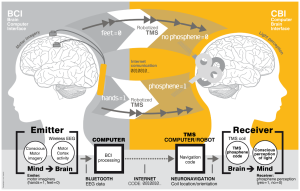
From: (Grau, et al., 2014)
https://journals.plos.org/plosone/article?id=10.1371/journal.pone.0105225
Over 10 years ago, Researchers at the University of California, Berkeley have shown that using functional Magnetic Resonance Imaging (fMRI) combined with some specialized computational models, they were able to reconstruct movie clips of what the person is viewing. (Anwar, 2011). More recently, researchers at the Swiss Federal Institute of Technology Lausanne were able to use AI to predict (Schneider, Lee, & Mathis, 2023) the next frame in a video by monitoring the brains of mice watching the film. (Sharma, 2023)
More recently, the advances in A.I. Large language Models have enabled scientists to use non-invasive brain imaging to reveal the movies in our mind. By recording brain activity while a subject watches a movie the A.I. (based on GPT-1) can construct sentences which describe what the person is seeing. To be successful, it does require cooperation of the subject both during the training session and when determining what they are watching. (Whang, 2023)
Figure 1‑24: Language Decoder for LLM A.I.

Source: https://www.biorxiv.org/content/biorxiv/early/2022/09/29/2022.09.29.509744/F1.large.jpg (Tang, LeBel, Jain, & Huth, 2022)
Elon Musk has taken a more invasive approach to mind reading with the Neuralink device. It consists of a battery-operated device (rechargeable from outside the body) with 1024 electrodes that record neural activity. These electrodes are so fine that it requires a custom surgical robot to perform the implant operation. (Figure 1‑25) (Fazekas, Neuralink, OpenWater, DARPA N3, aka how far is the full-immersive (MATRIX style) virtual reality?!, 2019). The FDA has approved the Neuralink for clinical studios (Levy, Taylor, & Sharma, 2023) but nobody has reported being implanted yet.
Figure 1‑25: Neuralink insertion robot
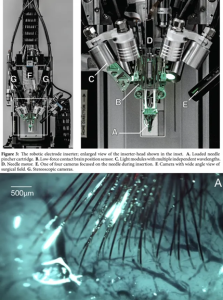
Source: https://miro.medium.com/v2/1*h6tAKQO9DdQxC3KCd1wYDA.png
From: https://thebojda.medium.com/neuralink-openwater-darpa-n3-aka-how-far-is-the-full-immersive-matrix-style-virtual-reality-2f5576fa343c
Augmented Reality (AR) and Virtual Reality (VR) Vision
While the brain interface is still in development, Augmented/Virtual Reality hardware and applications are in active development. From a visual perspective with AR, the user gets to see virtual objects and information overlaid on top of the real-world environment. A key feature to make this work is processing power to track the eye and head movements to ensure that the overlaid information matches with the physical world. Switching to a VR mode involves cutting off the visible portions of the real world and replacing it with a completely synthetic world.
With an initial focus on gaming there are four major players in the AR/VR vision market today:
- Microsoft HoloLens 2 – These goggles provide hand tracking, eye tracking and spatial mapping of the environment to allow the user to see and interact with virtual objects in the real environment. (Microsoft, 2023)
- Magic Leap ML2 – Currently the lightest of the goggles, it also provides a dimming mode which allow highlighting the virtual objects in an AR mode.(Magic Leap 2, 2023)
- Meta Quest Pro – Focused more heavily as a VR platform to allow users to collaborate in a Mixed Reality environment (Meta Quest Pro, 2023)
- Apple Vision Pro – The newest platform which hasn’t been released yet, it focuses on merging digital content into your physical space, offering multiple virtual monitors to interact with content (Apple Vision Pro, 2023)
The use of AR goggles isn’t necessarily limited to what a user can see. Researchers at MIT have modified a Microsoft Hololens headset to provide the wearer with a form of X-Ray Vision to enable the retail and warehouse workers locate items much faster. (LANDYMORE, 2023)
Another specialized form of Virtual Reality is the Sol Reader which focuses solely on providing an environment simply to read a book blocking out everything else. (Kamp, 2023)
OTHER SENSES IN VR
While VR goggles can go a long way to immersing a person in an environment, the other senses need to perceive being there. Sound is the easiest through headphones giving spatial audio so that the user perceives the location of the object which makes the sound.
Motion in a VR world is one of the more challenging to pull off. To this end, there are multiple companies creating VR treadmills (Figure 1‑26) which allow users to move around freely in a virtual environment while keeping them in the same safe location in the physical world. (Virtuix Omni One, 2023). These devices work by tethering the user on top of a platform which allows the user to walk, run, jump, and even swim by tracking the motion of the arms and legs.
Figure 1‑26: Virtuix Omni One VR Treadmill

Source: https://omni.virtuix.com/images/virtuix_o1_crouched.jpg
From: https://omni.virtuix.com/
For touch, there are haptic gloves which not only track the hand motion but can provide tactile feedback so that the wearer can sense the objects that they are touching in the virtual world. (HaptX Gloves G1, 2023) (Figure 1‑27). To fully experience the pressure and sounds of the environment, users can wear a haptic vest with speakers and motors and even electric shocks to provide feedback to other parts of the body, including a sensation of being attacked while playing a game. (Wöbbeking, 2023)
Figure 1‑27: Haptx Force Feedback VR Gloves
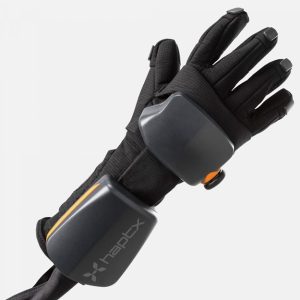
Source: https://haptx.com/wp-content/uploads/Glove_Only-1200×1200.jpg
From: https://haptx.com/
The hardest sense to fool is smell. This concept of “smell-o-vision” is difficult to accomplish because of the wide range of chemicals which the human nose can distinguish. As such, most attempts to provide scent to VR involve a limited number of scents typically generated by heating a scented wax. (Donlevy, 2023) (Whit, 2023)
The last sense of course is taste. Unfortunately taste depends very heavily on the sense of smell in addition to the sensors in the tongue. A leading researcher Nimesha Ranasinghe at the University of Maine has been fooling the tongue through the use of electrodes stimulating specific parts of the tongue. (Using Electric Currents to Fool Ourselves Into Tasting Something We’re Not, 2017).
AVATARS
These technologies combine to provide for the ultimate pairing of humans and machines – an avatar that allows a human to be tele-present in a robot at a separate location. This is a VR environment for a person which is fed by sensors on the remote robot. This avatar is useful in environments where a human could not survive, such as deep under water, in the vacuum of space, or on a remote planet with a hostile environment.
Recognizing the need for the technology, the XPrize foundation held an Avatar competition with $10M in prize money (XPrize Avatar Competition, 2023). In November 2022, 17 teams from around the world competed with judges operating the telepresence robots in a simulated space station on an alien planet. The judge had to use the avatar to complete tasks including flipping switches, navigating an obstacle course, identifying a container by wright, operate a drill and even determine whether a rock is smooth or rough by touch. (Ackerman, 2023)
Figure 1‑28: NimbRo XPRIZE Avatar Finals Operator Station
![]()
Source: http://nimbro.net/AVATAR/images/NimbRo_Avatar_2022_11_05_Finals_Day_2_Operator_Station.jpg
From: http://nimbro.net/AVATAR/
CONCLUSIONS
There are many ways in which we can integrate with the machines and computers of the world. Advancements in A.I and 3D Printing over the past decade have accelerated the rate at which we replace, augment, and connect our bodies to connect with the world.
QUESTIONS FOR STUDENTS
How do you draw the line for when a Replacement part becomes an Augmentation?
At what point in time does the ability an Augmentation provides become a concern for society?
REFERENCES
Ackerman, E. (2023, April 16). Your Robotic Avatar Is Almost Ready. Retrieved June 25, 2023 from IEEE Spectrum: https://spectrum.ieee.org/xprize-robot-avatar
Aggarwal, M., & Kumar, S. (2022, September). The Use of Nanorobotics in the Treatment Therapy of Cancer and Its Future Aspects: A Review. Cureus, 14(9), e29366.
Amoruso, E., Dowdall, L., Thomas Kollamkulam, M., Ukaegbu, O., Kieliba, P., Ng, T., . . . Makin, T. (2022, January). Intrinsic somatosensory feedback supports motor control and learning to operate artificial body parts. Journal of Neural Engineering, 19. doi:10.1088/1741-2552/ac47d9
Anwar, Y. (2011, September 22). Berkeley News. Retrieved June 25, 2023 from Scientists use brain imaging to reveal the movies in our mind: https://news.berkeley.edu/2011/09/22/brain-movies/
Apple Vision Pro. (2023, June 1). From Apple: https://www.apple.com/apple-vision-pro/
Ashley, S. (2017, February 21). Robotic Exoskeletons Are Changing Lives in Surprising Ways. Retrieved June 12, 2023 from NBC News: https://www.nbcnews.com/mach/innovation/robotic-exoskeletons-are-changing-lives-surprising-ways-n722676
Baseel, C. (2015, January 8). Want to buy a giant, rideable robot? Amazon Japan will sell you one. Retrieved June 16, 2023 from Sora News 24: https://soranews24.com/2015/01/08/want-to-buy-a-giant-rideable-robot-amazon-japan-will-sell-you-one/
Beck, O. N., Taboga, P., & Grabowski, A. M. (2022, January 5). Sprinting with prosthetic versus biological legs: insight from experimental data. Royal Society Open Science, 9(1), 1-13. Retrieved Jun 9, 2023 from Sprinting with prosthetic versus biological legs: https://doi.org/10.1007/s42235-022-00289-8
Boyle, R. (2011, May 2). Girl Scout Team Patents Prosthetic Hand Device, Helping a Toddler Write For the First Time. Retrieved June 6, 2023 from Popular Science: https://www.popsci.com/technology/article/2011-05/girl-scout-team-patents-prosthetic-hand-device-helping-toddler-write-first-time/
BRAVE ROBOTICS Inc. (2018, April 10). Project J-DEITE. Retrieved June 12, 2023 from J-Diete: https://j-deite.jp/
Browne, R. (2023, March 1). ‘Father of the cell phone’ says one day we’ll have devices embedded under our skin. Retrieved June 25, 2023 from CNBC: https://www.cnbc.com/2023/03/01/mobile-phone-inventor-next-generation-will-have-devices-in-their-skin.html
Buchholz, K. (2021, August 24). Chart: Where the Paralympics Beat the Olympics. Retrieved June 9, 2023 from Statista: https://www.statista.com/chart/25606/paralympics-olympics-comparison/
Carter, J. “. (2017, October 19). The Giant Robot Duel Was Underwhelming… And That’s Okay. Retrieved June 16, 2023 from GeekDad: https://geekdad.com/2017/10/giant-robot-duel/
Choi, C. Q. (2007, July 27). World’s First Prosthetic: Egyptian Mummy’s Fake Toe. Retrieved June 6, 2023 from Live Science: https://www.livescience.com/4555-world-prosthetic-egyptian-mummy-fake-toe.html
Chu, J. (2015, July 31). A Low-Cost, High-Performance Prosthetic Knee | MIT Department of Mechanical Engineering. Retrieved June 8, 2023 from MIT Department of Mechanical Engineering: https://meche.mit.edu/news-media/low-cost-high-performance-prosthetic-knee
Clarke, L. (2023, February 13). This biohacking company is using a crypto city to test controversial gene therapies. Retrieved June 25, 2023 from MIT Technology Review: https://www.technologyreview.com/2023/02/13/1068330/minicircle-prospera-honduras-biohacking-follistatin-gene-therapy/
Copy of Roman artificial leg, London, England, 1905-1915. (n.d.). Retrieved June 6, 2023 from Science Museum Group Collection: https://collection.sciencemuseumgroup.org.uk/objects/co84549/copy-of-roman-artificial-leg-london-england-1905-1915-artificial-leg
Daley, J. (2017, June 21). This 3000-Year-Old Wooden Toe Shows Early Artistry of Prosthetics. Retrieved June 6, 2023 from Smithsonian Magazine: https://www.smithsonianmag.com/smart-news/study-reveals-secrets-ancient-cairo-toe-180963783
Dangerous Things. (2019, June 24). xNT NFC Chip. Retrieved June 25, 2023 from Dangerous Things: https://dangerousthings.com/product/xnt/
Davis, N. (2023, March 2). Human augmentation with robotic body parts is at hand, say scientists. From The Guardian: https://www.theguardian.com/science/2023/mar/02/human-augmentation-with-robotic-body-parts-is-at-hand-say-scientists
de la Tejera, J. A., Bustamante-Bello, R., Ramirez-Mendoza, R. A., & Izquierdo-Reyes, J. (2020, December 24). Systematic Review of Exoskeletons towards a General Categorization Model Proposal. Retrieved June 9, 2023 from MDPI: https://www.mdpi.com/2076-3417/11/1/76
Dempsey, G. J., Murray, K., Greqell, M., Groat, Z., Pohlen, C., & Anderson, M. W. (2014, September 23). United States of America Patent No. 8,840,157.
Donlevy, K. (2023, May 10). VR ‘Smell-o-vision’ may enable users to detect dozens of odors. Retrieved June 25, 2023 from New York Post: https://nypost.com/2023/05/10/vr-smell-o-vision-may-enable-users-to-detect-dozens-of-odors/
Dvorsky, G. (2017, June 21). This 3,000-Year-Old Prosthetic Wooden Toe is More Incredible Than We Thought. Retrieved June 6, 2023 from Gizmodo: https://gizmodo.com/this-3-000-year-old-prosthetic-wooden-toe-is-more-incre-1796274259
Enabling The Future. (n.d.). Retrieved June 6, 2023 from Enabling The Future – A Global Network Of Passionate Volunteers Using 3D Printing To Give The World A “Helping Hand.”: https://enablingthefuture.org/
Fazekas, L. (2019, May 19). How does OpenWater’s mind reader work?! Retrieved June 25, 2023 from Medium: https://thebojda.medium.com/how-does-openwaters-mind-reader-work-750bea176aeb
Fazekas, L. (2019, July 28). Neuralink, OpenWater, DARPA N3, aka how far is the full-immersive (MATRIX style) virtual reality?! Retrieved June 25, 2023 from Medium: Neuralink, OpenWater, DARPA N3, aka how far is the full-immersive (MATRIX style) virtual reality?!
FIRST Robotics. (2021, January 4). FIRST Robotics Competition Team Creates Prosthetic Hand. Retrieved June 6, 2023 from community: https://community.firstinspires.org/first-robotics-competition-team-creates-prosthetic-hand
Firtina, N. (2023, February 28). Watch: 3D printing living cells inside human body becomes a reality. Retrieved June 16, 2023 from Interesting Engineering: https://interestingengineering.com/health/3d-printing-living-cells-human-reality
Global Agenda Councel on the Future of Software & Society. (2015, November 1). Deep Shift 21 Ways Software Will Transform Global Society. Retrieved June 25, 2023 from World Economic Forum: https://www3.weforum.org/docs/WEF_GAC15_Deep_Shift_Software_Transform_Society.pdf
Goth, G. (2023, June 12). New Nanotattoos Don’t Need Batteries or Wires. Retrieved June 23, 2023 from IEEE Spectrumm: https://spectrum.ieee.org/nano-tattoo
Graafstra, A. (2017, May 1). Making payments with an implant. Retrieved June 25, 2023 from Dangerous Things: https://forum.dangerousthings.com/t/making-payments-with-an-implant/643
Grau, C., Ginhoux, R., Riera, A., Nguyen, T. L., Chauvat, H., Berg, M., . . . Ruffini, G. (2014, August). Conscious Brain-to-Brain Communication in Humans Using Non-Invasive Technologies. PLOS ONE, 9, e105225. doi:10.1371/journal.pone.0105225
Grunewald, S. J. (2016, February 19). Three Year Old Gets His Own Iron Man e-NABLE Prosthetic Hand. Retrieved June 6, 2023 from 3DPrint.com: https://3dprint.com/120465/iron-man-e-nable-hand/
Halfacree, G. (2023, April 5). A Soft Wearable Ultrasound Sensor Peers Deep Under Your Skin to Monitor Muscles and More. Retrieved June 25, 2023 from Hackster.io: https://www.hackster.io/news/a-soft-wearable-ultrasound-sensor-peers-deep-under-your-skin-to-monitor-muscles-and-more-4e349a63eb16
HaptX Gloves G1. (2023, June 1). Retrieved June 25, 2023 from haptx: https://g1.haptx.com/learnabout
Haworth, S. (2023). About Steve Haworth Modified. Retrieved June 25, 2023 from Steve Haworth Modified: http://stevehaworth.com/about/
Hofmann, J. (2016, September 14). biotINK – the bioprinter of tomorrow. Retrieved June 16, 2023 from Hackaday.io: https://hackaday.io/project/14501-biotink-the-bioprinter-of-tomorrow
HT Tech. (2021, May 14). ‘Kuratas’ Japan’s futuristic robot. Retrieved June 16, 2023 from HT Tech: https://tech.hindustantimes.com/photos/kuratas-japan-s-futuristic-robot-photo-62Ez674kIU0EyCkfrFGTUK-6.html
Hypershell. (2023). Hypershell: Exoskeleton for Everyday Adventure. Retrieved June 9, 2023 from Indiegogo: https://www.indiegogo.com/projects/hypershell-exoskeleton-for-everyday-adventure–2#/
Iowa Girl Scouts. (2011, April 20). Iowa Girl Scouts Invent Prosthetic Hand for Three-Year-Old Girl and Win up to $20,000 to Patent it in Inaugural First® LEGO® League Global Innovation Award. Retrieved June 6, 2023 from PR Newswire: https://www.prnewswire.com/news-releases/iowa-girl-scouts-invent-prosthetic-hand-for-three-year-old-girl-and-win-up-to-20000-to-patent-it-in-inaugural-first-lego-league-global-innovation-award-120294524.html
Japan, g. (2020, December 2). Retrieved June 12, 2023 from Japan Today: https://japantoday.com/category/entertainment/japan%E2%80%99s-new-life-size-moving-gundam-statue-unveiled-in-full-dramatic-glory
Kamp, H. J. (2023, June 9). Sol Reader is a VR headset exclusively for reading books. Retrieved June 25, 2023 from TechCrunch: https://techcrunch.com/2023/06/09/sol-reader/
Kelley, L. C. (1919, July 1). US1308675A – Pedomotor. Retrieved June 9, 2023 from Google Patents: https://patents.google.com/patent/US1308675A/en
Kuritas. (2023, June 9). Retrieved June 16, 2023 from Wikipedia: https://en.wikipedia.org/wiki/Kuratas
LANDYMORE, F. (2023, March 2). HEADSET THAT CAN SEE INSIDE BOXES. Retrieved June 25, 2023 from Futurism: https://futurism.com/the-byte/mit-headset-find-objects
Levin, D. (2022, March 14). Stanford bioengineers aim to build a heart, one layer at a time. Retrieved June 16, 2023 from Stanford News: https://news.stanford.edu/2022/03/14/building-heart-one-layer-time/
Levy, R., Taylor, M., & Sharma, A. (2023, May 26). Elon Musk’s Neuralink wins FDA approval for human study of brain implants. Retrieved June 25, 2023 from Reuters: https://www.reuters.com/science/elon-musks-neuralink-gets-us-fda-approval-human-clinical-study-brain-implants-2023-05-25/
Liu, S., Gao, C., & Peng, F. (2022). Micro/nanomotors in regenerative medicine. Materials Today Advances, 16, 100281. doi:10.1016/j.mtadv.2022.100281
Magic Leap 2. (2023, June 1). From Magic Leap: https://www.magicleap.com/magic-leap-2
Melanie, K., Markus, G., Phillipp, H., & Oliver, F. (2019). Ultra-Low-Cost 3D Bioprinting: Modification and Application of an Off-the-Shelf Desktop 3D-Printer for Biofabrication. Frontiers in Bioengineering and Biotechnology, 7. doi:10.3389/fbioe.2019.00184
Meta Quest Pro. (2023, June 1). From Meta: https://www.meta.com/quest/quest-pro/
Microsoft. (2023). HoloLens 2 Features. From Microsoft: https://www.microsoft.com/en-us/hololens/hardware
MIT GEAR Lab. (n.d.). Prosthetic Leg — MIT GEAR Lab. Retrieved June 8, 2023 from MIT GEAR Lab: https://www.gear.mit.edu/prosthetic-knee
MIT Media Lab. (2019, December 2). This MIT engineer built his own bionic leg — MIT Media Lab. Retrieved June 8, 2023 from MIT Media Lab: https://www.media.mit.edu/articles/this-mit-engineer-built-his-own-bionic-leg/
MIT Media Lab. (n.d.). Overview ‹ Biomechatronics — MIT Media Lab. Retrieved June 8, 2023 from MIT Media Lab: https://www.media.mit.edu/groups/biomechatronics/overview/
MIT Media Lab. (n.d.). Transfemoral Powered Prostheses – Biomechatronics. Retrieved June 8, 2023 from Biomechatronics – MIT Media Lab: https://biomech.media.mit.edu/portfolio_page/cseaknee/
MIT News. (2015, July 31). A cheaper, high-performance prosthetic knee | MIT News | Massachusetts Institute of Technology. Retrieved June 8, 2023 from MIT News: https://news.mit.edu/2015/cheaper-high-performance-prosthetic-knee-0731
Nanomedicine. (2023, February 6). From Wikipedia: https://en.wikipedia.org/wiki/Nanomedicine
Nanorobotics. (2023, December 5). From Wikipedia: https://en.wikipedia.org/wiki/Nanorobotics
National Nanotechnology Coordination Office. (2023). About the NNI. From National Nanotechnology Initiative: https://www.nano.gov/about-nni
National Nanotechnology Coordination Office. (2023). Applications of Nanotechnology. Retrieved June 25, 2023 from National Nanotechnology Initirative: https://www.nano.gov/about-nanotechnology/applications-nanotechnology
Otte, A., & Hazubski, S. (2019, March 3). The Ancient Artificial Leg of Capua: First 3D Print after 2300 Years. Retrieved June 6, 2023 from MDPI: https://www.mdpi.com/2673-1592/3/3/19
Ottobock. (2021, November 3). suitX by Ottobock. Retrieved June 12, 2023 from suitX: https://www.suitx.com/
Qui, S., Pei, Z., & Wang, C. (2022). Systematic Review on Wearable Lower Extremity Robotic Exoskeletons for Assisted Locomotion. J Bionic Eng. From https://doi.org/10.1007/s42235-022-00289-8
Robertson, A. (2017, July 21). I hacked my body for a future that never came. Retrieved June 25, 2023 from The Verge: https://www.theverge.com/2017/7/21/15999544/biohacking-finger-magnet-human-augmentation-loss
Sánchez, E. (2023, March 27). Telepathy Experiments in Silicon Valley. Retrieved June 25, 2023 from Exploring Your Mind: https://exploringyourmind.com/telepathy-experiments-in-silicon-valley/
Schneider, S., Lee, J. H., & Mathis, M. W. (2023). Learnable latent embeddings for joint behavioural and neural analysis. Nature, 617, 360–368. doi:10.1038/s41586-023-06031-6
Schroeder, K. (2022, March 29). ‘Biohackers’ and DIY Gene Therapy. Retrieved June 25, 2023 from Front Line Genomics: https://frontlinegenomics.com/biohackers-and-diy-gene-therapy/
Sharma, S. (2023, May 4). This new AI tool uses brain signals to predict what a mouse sees. Retrieved June 25, 2023 from Interesting Engineering: https://interestingengineering.com/science/ai-tool-uses-brain-signals-to-predict-what-a-mouse-sees
Shift Robotics. (2023, 1 1). Moonwalkers Deposit – Shift Robotics. Retrieved June 9, 2023 from Shift Robotics: https://shiftrobotics.io/products/moonwalkers
Shirley Ryan AbilityLab. (n.d.). Research | Shirley Ryan AbilityLab. Retrieved June 8, 2023 from AbilityLab: https://www.sralab.org/research
Soon, R. H., Yin, Z., Dogan, M. A., Dogan, N. O., Tiryaki, M. E., Karacakol, A. C., . . . Sitti, M. (2023). Pangolin-inspired untethered magnetic robot for on-demand biomedical heating applications. Nature Communications, 14, 3320. doi:10.1038/s41467-023-38689-x
Stanford University. (n.d.). Biomechatronics Laboratory. Retrieved June 8, 2023 from Stanford Biomechatronics Laboratory: https://biomechatronics.stanford.edu/
Taguchi Industrial. (2023, June 16). Guzzilla D Series Crusher. From Taguchi Iindustrial: https://www.taguchi-industrial.com/en/product/guzzilla-crasher-d/
Tang, J., LeBel, A., Jain, S., & Huth, A. G. (2022). Semantic reconstruction of continuous language from non-invasive brain recordings. bioRxiv. doi:10.1101/2022.09.29.509744
Teresa, D. (2022, August 1). A transhuman biohacker implanted over 50 chips and magnets in her body. Retrieved June 25, 2023 from Interesting Engineering: https://interestingengineering.com/innovation/transhuman-biohacker-implanted-magnets
Thai, M. T., Phan, P. T., Tran, H. A., Nguyen, C. C., Hoang, T. T., Davies, J., . . . Do, T. N. (2023, February 19). Advanced Soft Robotic System for In Situ 3D Bioprinting and Endoscopic Surgery. Advanced Science, 2023(10), 2205656. doi:https://doi.org/10.1002/advs.202205656
Trafton, A. (2023, January 31). How to make hyrdogels more injectable. Retrieved June 16, 2023 from MIT News: https://news.mit.edu/2023/hydrogels-blocks-injectable-tissue-repair-0131
txyz.info. (2014, February 23). Bionic Yourself V2.0. Retrieved June 25, 2023 from Hackaday.io: https://hackaday.io/project/2736-bionic-yourself-v20
University of California at Berkeley. (n.d.). Research Areas and Major Fields | UC Berkeley Mechanical Engineering. Retrieved June 8, 2023 from UC Berkeley Mechanical Engineering: https://me.berkeley.edu/research-areas-and-major-fields/
University of Twente. (2020, December 9). Retrieved June 8, 2023 from Neurotechnology and Biomechatronics | Electrical Engineering: https://www.utwente.nl/en/education/master/programmes/electrical-engineering/specialisation/neurotechnology-biomechatronics/
Using Electric Currents to Fool Ourselves Into Tasting Something We’re Not. (2017, August 15). Retrieved June 25, 2023 from Smithsonian Magazine: https://www.smithsonianmag.com/innovation/using-electric-currents-to-fool-ourselves-into-tasting-something-were-not-180970005/
Verheyen, C. A., Uzel, S. G., Kurum, A., Roche, E. T., & Lewis, J. A. (20223, March 1). Integrated data-driven modeling and experimental optimization of granular hydrogel matrices. Matter, 6(3), 1015-1036. doi:https://doi.org/10.1016/j.matt.2023.01.011
Virtuix Omni One. (2023, June 1). Retrieved June 25, 2023 from Virtuix: https://omni.virtuix.com/
Wang, X. (2019, Jan). Bioartificial Organ Manufacturing Technologies. Cell Transplantation, 28(1), 5-17. doi:10.1177/0963689718809918
Whang, O. (2023, May 1). A.I. Is Getting Better at Mind-Reading. Retrieved June 23, 2923 from New York Times: https://www.nytimes.com/2023/05/01/science/ai-speech-language.html
Whit, C. (2023, May 10). 2 Odor Generator Formats Could Be the Solution To Incorporate Scents Into Virtual Reality. Retrieved June 25, 2023 from The Science Times: https://www.sciencetimes.com/articles/43683/20230510/2-odor-generator-formats-solution-incorporate-scents-virtual-reality.htm
Wikipedia. (2023, April 30). 3D Bioprinting. Retrieved June 16, 2023 from Wikipedia: https://en.wikipedia.org/wiki/3D_bioprinting
Wöbbeking, J. (2023, January 22). Electric haptic vest makes for shocking VR experiences. Retrieved June 25, 2023 from Mixed News VR Hardware: https://mixed-news.com/en/electric-haptic-vest-makes-for-shocking-vr-experiences/#:~:text=The%20Owo%20haptic%20vest%20provides,or%20stabbed%20in%20VR%20games.
XPrize Avatar Competition. (2023, April 16). Retrieved June 25, 2023 from XPrize: https://www.xprize.org/prizes/avatar
YAGN, N. (1890, November 18). US440684A – Apparatus for facilitating walking. Retrieved June 9, 2023 from Google Patents: https://patents.google.com/patent/US440684A/en
Zhang, S. (2018, February 20). A Biohacker Regrets Publicly Injecting Himself With CRISPR. Retrieved June 25, 2023 from The Atlantic: https://www.theatlantic.com/science/archive/2018/02/biohacking-stunts-crispr/553511/

